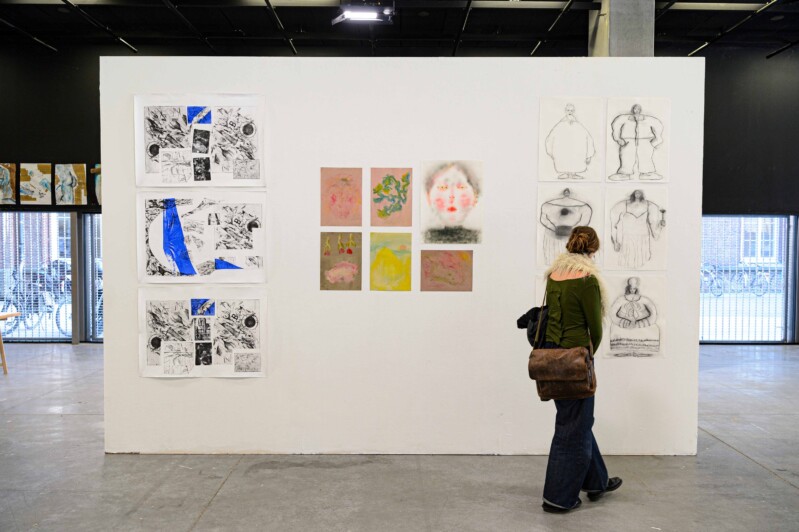you can choose one of these options
printmakinggraphic designprogrammeillustrationgraphic designprogrammegraphic design studiographic designprogrammegraphic design
graduating option graphic design
3 study paths in the bachelor
1 study path in the master
3+1 years
English master
read more about the programme
Situation of the programme
Artists have routinely engaged with print media since its creation, as a result of the vast expansion of visual and communication culture. The book, the edition, the printed series, the illustrated novel, the daily newspaper, the periodical publication, the artist's book... became the playground of graphic artists, graphic designers and illustrators. A complex set of graphic practices emerged that determined the character and development of our current massified visual culture and the development of the arts. These graphic practices are intertwined with both artistic and non-artistic streams of image and text production. Moreover, the graphic revolution gave visual culture a totally new impetus. You therefore cannot see illustration, graphics and graphic design separately from each other. The graphic field is thus interdisciplinary and the practice of the graphic artist, designer or illustrator has many faces as a result.
Broad base
he graduating option is based on three study paths, each with its own studio: printmaking, graphic design and illustration. During the first bachelor, you will be introduced to the principles of the artistic work processes and design methods of each of the three practices. You will gain insight into their technical aspects, their contexts and their artistic problems. At the start of the second semester, you are asked to focus by choosing a main practice studio. You specialise in one of the three graphic practices. In each main studio, there is broader initiation, but also and above all in-depth work. In two smaller sub-studios, however, you continue to create from the specificities and with the possibilities of the two other graphic disciplines. The work done in the sub-studios relates closely to the way you work in the main studio. The basic, main and substudio practices of the three graphic disciplines are flanked throughout the year by lessons in drawing, graphic techniques and typography.
Specialisation and cooperation
From the second bachelor, you choose one of the three study paths: printmaking, graphic design or illustration. This means that you explore the specific technical aspects, the contexts and the artistic and/or design issues linked to the discipline you choose in a specialised way and use them to develop an individual practice. The graduating option also maintains a strong commitment to collaboration across the three separate disciplines from the second bachelor. This is what the hybridity and interdisciplinarity of the graphic field requires.
Master of graphic design
In the master's programme, you will have even more space to develop your own graphic practice. The master's programme supports and encourages you to develop and coordinate your own projects independently. You choose which mentors act as your sounding board. You will receive theoretical stimuli in specialised master's seminars of your choice. Frequent consultation and contact with all other master students in graphic design ensures an open, fresh view on your own work process. Testing and feeding your own artistic practice is explicitly related to the professional field. You will actively participate in design studios, in newspaper and magazine publishing houses, in art print studios, as an assistant to artists, in museums and in the cultural field as a whole. The master's programme results in a finished master's project that is assessed by teachers and by specialists from the field.
teachers
study programme print making
study programme illustration
study programme graphic design
study programme master
enrolment and tests
how do you register for the bachelor's degree?
see the dates and assignments for the test
how do you register for the master's degree?
see the dates and assignments for the test
If you want to apply for an academic bachelor's degree, you must first pass an artistic admission test. To enter the master's programme, you will take part in an orientation test. These are organised several times per academic year.
english master
In addition to a Dutch-language master, this study path also has a fully English-language counterpart. Every academic year, dozens of foreign students start in the English master's at KASK & Conservatorium.
There are no differences in curricula, competencies, learning outcomes or organization between the English-language programmes and their Dutch-language counterparts. Don’t hesitate to contact the study and learning track counsellors with your questions.
2, Jozef Kluyskensstraat
9000 Ghent
—
Cloquet
2, Louis Pasteurlaan
9000 Ghent
—
Kunsttoren
5, Offerlaan
900 Ghent
credits
- —
- Amélie Verleene, Graduation 2021, photo: Jordi Coppers
- Ann-Sofie Verhoyen, The Lark Ascending, 2023



















